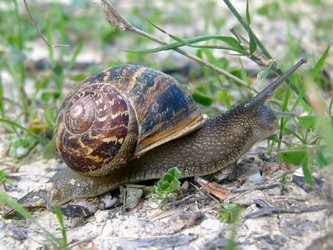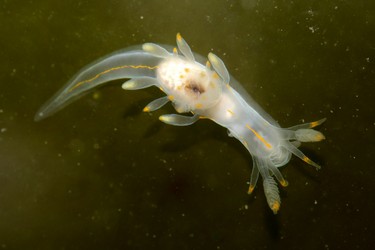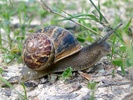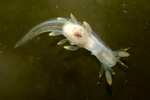Heterobranchia



This tree diagram shows the relationships between several groups of organisms.
The root of the current tree connects the organisms featured in this tree to their containing group and the rest of the Tree of Life. The basal branching point in the tree represents the ancestor of the other groups in the tree. This ancestor diversified over time into several descendent subgroups, which are represented as internal nodes and terminal taxa to the right.

You can click on the root to travel down the Tree of Life all the way to the root of all Life, and you can click on the names of descendent subgroups to travel up the Tree of Life all the way to individual species.
For more information on ToL tree formatting, please see Interpreting the Tree or Classification. To learn more about phylogenetic trees, please visit our Phylogenetic Biology pages.
close boxReferences
Colgan, D. J., W. F. Ponder, and P. E. Eggler. 2000. Gastropod evolutionary rates and phylogenetic relationships assessed using partial 28S rDNA and histone H3 sequences. Zoologica Scripta 29(1):29-63.
Dayrat, B. and S. Tillier. 2002. Evolutionary relationships of euthyneuran gastropods (Mollusca): a cladistic re-evaluation of morphological characters. Zoological Journal of the Linnean Society 135:403-470.
Dayrat, B., A. Tillier, G. Lecointre, and S. Tillier. 2001. New clades of euthyneuran gastropods (Mollusca) from 28S rRNA sequences. Molecular Phylogenetics and Evolution 19:225-235.
Grande, C., J. Templado, J. L. Cervera and R. Zardoya. 2004. Molecular phylogeny of Euthyneura (Mollusca: Gastropoda). Molecular Biology and Evolution 21(2):303-313.
Haszprunar, G. 1985. The fine morphology of the osphradial sense organs of the Mollusca. Part 1: Gastropoda- Prosobranchia. Philosophical Transactions of the Royal Society of London Series B 307:457–496.
Haszprunar, G. 1985b. The Heterobranchia- a new concept of the phylogeny and evolution of the higher Gastropoda. Zeitschrift für Zoologische Systematik und Evolutionsforsch 23:15–37.
Haszprunar, G. 1988. On the orgin and evolution of major gastropod groups, with special reference to the Streptoneura (Mollusca). Journal of Molluscan Studies 54:367–441.
Klussmann-Kolb, A., A. Dinapoli, K. Kuhn, B. Streit, and C. Albrecht. 2008. From sea to land and beyond - new insights into the evolution of euthyneuran Gastropoda (Mollusca). BMC Evolutionary Biology 8:57. doi:10.1186/1471-2148-8-57
Ponder,W. F. 1991. Marine valvatoidean gastropods — implications for early heterobranch phylogeny. Journal of Molluscan Studies 57:21–32.
Ponder,W. F. and A. Warén. 1988. Classification of the Caenogastropoda and Heterostropha — a list of the family-group and higher category names. Malacological Review Suppl. 4:288–326.
Thollesson, M. 1999. Phylogenetic analysis of Euthyneura (Gastropoda) by means of the 16s rRNA gene: use of a fast gene for higher-level phylogenies. Proc. R. Soc. Lond. Ser. B 266:75-83.
Title Illustrations

| Scientific Name | Helix aspersa |
|---|---|
| Location | Iraklio, Crete, Greece |
| Specimen Condition | Live Specimen |
| Source | To boldly go... |
| Source Collection | Flickr |
| Image Use |
 This media file is licensed under the Creative Commons Attribution-NonCommercial-NoDerivs License - Version 2.0. This media file is licensed under the Creative Commons Attribution-NonCommercial-NoDerivs License - Version 2.0.
|
| Copyright | © 2006 Stavros Markopoulos |
| Scientific Name | Ancula gibbosa |
|---|---|
| Location | Bean Hollow State Beach, Pescadero, California, United States |
| Comments | Observed in the rocky intertidal. |
| Specimen Condition | Live Specimen |
| Identified By | Ken-ichi Ueda |
| Sex | Hermaphroditic |
| Life Cycle Stage | Adult |
| Size | ~2-3cm |
| Source | Humped Ancula! |
| Source Collection | Flickr |
| Image Use |
 This media file is licensed under the Creative Commons Attribution-NonCommercial-ShareAlike License - Version 2.0. This media file is licensed under the Creative Commons Attribution-NonCommercial-ShareAlike License - Version 2.0.
|
| Copyright |
© 2007 Ken-ichi Ueda

|
About This Page
Page copyright © 2008
All Rights Reserved.
- First online 09 February 2008
- Content changed 09 February 2008
Citing this page:
Tree of Life Web Project. 2008. Heterobranchia. Version 09 February 2008 (temporary). http://tolweb.org/Heterobranchia/20280/2008.02.09 in The Tree of Life Web Project, http://tolweb.org/









 Go to quick links
Go to quick search
Go to navigation for this section of the ToL site
Go to detailed links for the ToL site
Go to quick links
Go to quick search
Go to navigation for this section of the ToL site
Go to detailed links for the ToL site